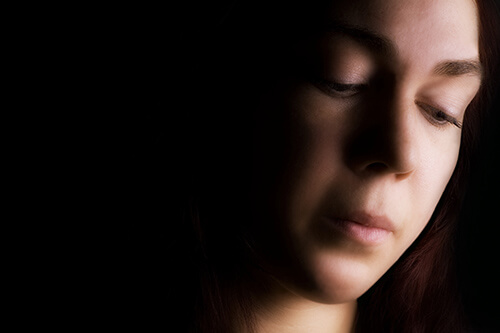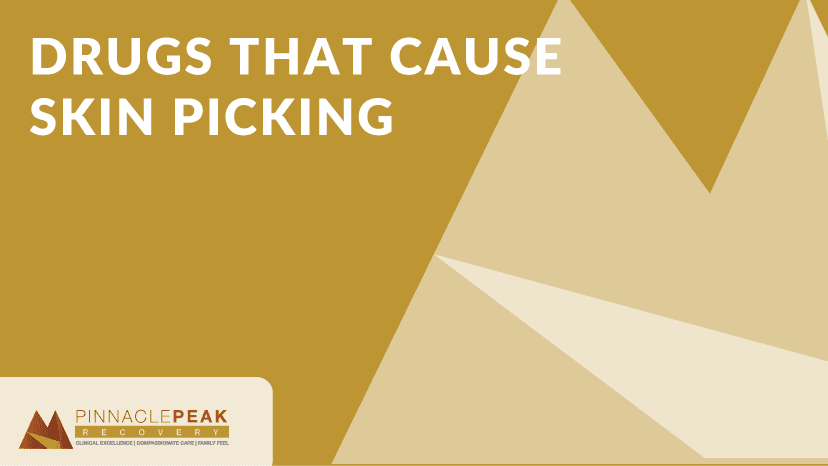So you’ve noticed that a loved one has developed some scabs or marks on their skin and you’re trying to figure out why. Skin picking can come in many forms and occur for a variety of reasons. For some with neurological disorders, skin picking can be a tick or way to try and alleviate stress. For others, it can be a condition on its own or a side effect of substances that they’re consuming. Today we’re going to be primarily focusing on drugs that cause skin picking.

Here at Pinnacle Peak Recovery in Arizona, we understand that a substance use disorder (SUD) can impact your life in more ways than one. Talking about all aspects of substance use and how it can impact a person can help us destigmatize SUDs and recovery.
Side Effects of Substance Use Disorder
Substance use becomes a substance use disorder when you find more than one of these things to be true: that the majority of your day is taken up by your substance use (by taking the drug, thinking about it, or coming down from it) when you quit activities you used to enjoy to prioritize substance use when you’re unable to stop substance use even when you want to, and when your relationships start being impacted by your substance use.
With any level of substance use, there’s a chance for side effects, but the longer someone partakes in a substance, the higher their chance of experiencing side effects. In addition to this, there are long-term effects that can occur with substance use as well.
When it comes to skin picking, there are two primary substances that can lead to this side effect happening. These are cocaine and meth, which both happen to be stimulants.
Cocaine Use Disorder
Cocaine primarily comes in a powdered form and is usually consumed by snorting or rubbing on the gums. In some cases, though, people may also take cocaine by injecting it. The way someone consumes cocaine can affect some of the side effects they may experience because of it. For example, those who snort cocaine can damage their nasal passageways leading to frequent runny or bloody noses, inflammation, and even the breaking down of the nasal lining.
Here are some other common side effects of cocaine use disorder:
- Constricted blood vessels
- Dilated pupils
- Fast or irregular heartbeat
- Tremors and muscle twitches
- Restlessness
- Irritability
- Paranoia
- An increased sensitivity to light, sound, and touch
When it comes to skin picking, this can stem from a couple of things with cocaine use. If someone regularly consumes cocaine via injection, they might get scabbing and marks on their skin. During times of restlessness, you might be inclined to pick at these marks. In addition, side effects like paranoia can lead to problems like skin picking from stress or other thoughts that could lead you to believe you need to.
Does Your Loved One Need Help With Drug Addiction? Gives Us A Call Today!
Meth Use Disorder
Like cocaine, meth usually comes in a powdered form, but can be taken by snorting, consumption, injection, or smoking. Skin picking is a common side effect of meth use.
Meth is known to be linked with psychosis and other mental illnesses for those who use it heavily or long-term. A common side effect of meth use is hallucinations, even outside of a high. Many cases of skin picking occur because of the hallucinations caused by meth. People often experience “bugs” crawling on or under the skin during a hallucination. In order to try and relieve themselves of the bugs, they pick at their skin.
This isn’t the only side effect someone might experience with a meth use disorder, however. Here are just a few more of the common ones:
- Anxiety
- Depression
- Psychosis
- Fatigue
- Hallucinations
- Weight loss
- Difficulties sleeping
- Tooth decay
- Increased risk of heart disease and stroke
What Are the Other Signs of a Skin Picking Disorder?
Picking at your skin sometimes does not mean you have a skin-picking disorder. If you find you cannot stop picking your skin, you’re often injured because of skin picking, pick your skin unconsciously, or pick it when you’re stressed or anxious then you might have a skin picking disorder.
Do skin-picking disorders occur on their own? Are they usually tied to other mental health conditions or substance use disorders? What can you do to help yourself if you have a skin-picking disorder? Let’s learn more.
What is Dermatillomania?
Dermatillomania is one of many names for a skin-picking disorder. In the DSM-5 it’s referred to as Excoriation Disorder, though many people just refer to it as a skin-picking disorder. Dermatillomania is when someone repetitively picks at their own skin. This can be an obsessive-compulsive-geared desire to have no imperfections on your skin, or it could be a mindless or stress-induced subconscious action.
How Common is This Condition?
Somewhere between 2%-5% of people are impacted by skin picking enough that it damages tissue and impairs their quality of life. Approximately 75% of people who have Dematillomania are female.
Is Dermatillomania Contagious?
This condition is not contagious. Many people who have this condition start showing signs in early adolescence, but there is no time frame for when this condition develops. Some people may develop it later in life due to trauma or other mental illness, or even from substance use.
How to Help Yourself if You Have a Skin Picking Disorder
If you’ve noticed your skin picking and are unable to stop on your own, are seriously damaging your skin, or are having your daily life impacted by your skin picking, it might be time to see a doctor. Many times, talk therapy can be very effective in helping those managing a skin-picking disorder, but there are other steps you can take to assist yourself.
- Find other ways to distract your hands, things like fidget toys can be very helpful
- Try to identify your triggers for skin picking
- When the urge arises, take care of your skin instead. For example, you could apply lotion
- Keep your skin clean to help avoid infection
If you are experiencing skin picking as a result of substance use, this too can be treated. By addressing the substance use and going through a treatment program, you can work towards healing both your SUD and your skin picking disorder at the same time.
Getting Treatment For Substance Use Disorder at Pinnacle Peak
If you find that your substance use disorder is impacting your life in a way you no longer want it to, we’re here to help. Here at Pinnacle Peak Recovery, we offer everything from detox programs to inpatient and outpatient treatment. We’ll work with you to establish your goals and find the right path to ensure you reach them.
In addition, we understand that not everyone who has a substance use disorder is going through the same thing. Sometimes people also have mental health issues that need to be addressed in order to get the recovery they deserve. This is why we offer options in our programs to treat both mental illness and substance use disorders together. We want to treat the whole person, not just a singular concern.
If you'd like to learn more about our treatment programs or if you have any questions, give us a call today 866-377-4761.
Is You Family Member Having Side Effects From Drug Addiction? Give Us A Call Today.
FAQs About Drugs That Cause Skin Picking
How does skin-picking disorder occur?
Skin-picking disorder falls under the obsessive-compulsive category. It can be something someone’s born with, or it can develop due to trauma or other mental illnesses and substance use.
What are the symptoms of a skin-picking disorder?
The primary symptoms are picking without noticing, leaving marks and injuries on your skin because of picking, and picking at your skin when you’re stressed.
Can heroin cause skin-picking disorder?
Heroin use can lead to itchy skin and scarring due to injections. Both of these can contribute to skin-picking.


